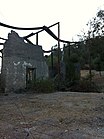
Mission San Antonio de Padua is a Spanish mission established by the Franciscan order in present-day Monterey County, California, near the present-day town of Jolon. Founded on July 14, 1771, it was the third mission founded in Alta California by Father Presidente Junípero Serra. The mission was the first use of fired tile roofing in Upper California. Today the mission is a parish church of the Diocese of Monterey and is no longer active in the mission work which it was set up to provide.
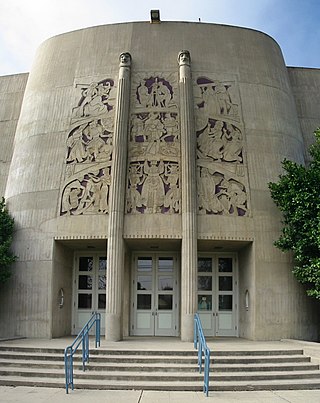
King City is a city in Monterey County, California, United States. It is located on the Salinas River 51 miles (82 km) southeast of Salinas, at an elevation of 335 feet (102 m). It lies along U.S. Route 101 in the Salinas Valley of California's Central Coast. King City is a member of the Association of Monterey Bay Area Governments. The population was 13,332 at the 2020 census, up from 12,874 in 2010.
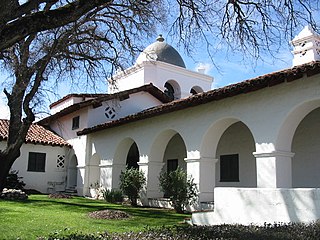
The Hacienda is the current name for a hotel in Monterey County, California, that was completed in 1930 for use by William Randolph Hearst as temporary housing for his employees and guests and headquarters for activities taking place on the surrounding land. The lodge building, designed by architect Julia Morgan, replaced and expanded upon an earlier wooden structure known as the Milpitas Ranch House which was destroyed by fire in the 1920s. The 1930 hotel has also been known as Milpitas Hacienda, Hacienda Guest Lodge and Milpitas Ranchhouse, under which name the property was placed in the National Register of Historic Places on December 2, 1977.

The Stagecoach Inn Museum in Newbury Park, California, originally known as the Grand Union Hotel, was used as a resting area for people who traveled from Los Angeles to Santa Barbara. Besides a hotel and stagecoach stop, it has also been used as a post office, church, restaurant and military school. It is California Historical Landmark No. 659 and is listed in the National Register of Historic Places. It played a major role in the development of the stage line transportation network in California. The hotel was also the first business venture in the Conejo Valley.

Monterey State Historic Park is a historic state park in Monterey, California. It includes part or all of the Monterey Old Town Historic District, a historic district that includes 17 contributing buildings and was declared a National Historic Landmark in 1970. The grounds include California's first theatre, and the Monterey Custom House, where the American flag was first raised over California.
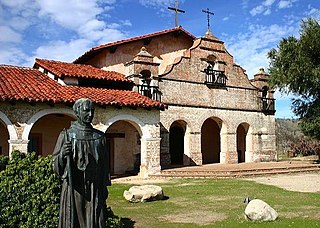
Jolon is small unincorporated village in southern Monterey County, California. Jolon is located in the San Antonio River Valley, west of Salinas Valley.
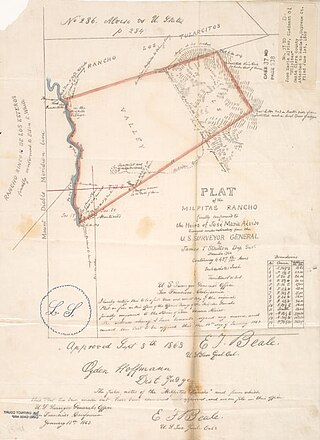
Rancho Milpitas was a 4,458-acre (18.04 km2) Mexican land grant in Santa Clara County, California. The name comes from the Nahuatl word for maize and could be translated "little cornfields". The grant included what is now the city of Milpitas.

Deetjen's Big Sur Inn, a collection of single wall buildings, cabins, and a restaurant in Castro Canyon, was one of the first visitor accommodation to offer overnight lodging and meals to Big Sur, California visitors and travelers after the opening of Highway 1 in 1937. Helmuth Deetjen initially built cottages for others in Carmel, and was attracted to the Big Sur coast that reminded him of Norway. In 1926, he bought 6 acres (2.4 ha) and began construction of a home. He met Helen Haight and when Highway 1 was completed in 1937, they opened an inn. Helmuth managed the Inn until his death in October 1972, when its operation passed to a non-profit foundation. The Inn was closed for a short time after the Soberanes Fire and subsequent winter floods damaged several structures.
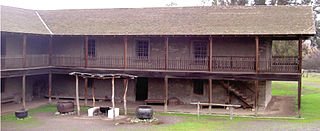
Monterey Colonial is an architectural style developed in Alta California. Although usually categorized as a sub-style of Spanish Colonial style, the Monterey style is native to the post-colonial Mexican era of Alta California. Creators of the Monterey style were mostly recent immigrants from New England states of the US, who brought familiar vernacular building styles and methods with them to California.

This is a list of the National Register of Historic Places listings in Monterey County, California.

The Jose Eusebio Boronda Adobe is a Monterey Colonial style building from 1846, located in Salinas, Monterey County, California.
Dutton House may refer to:
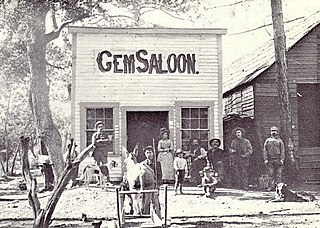
Manchester was a mining town in the southern Big Sur region of Monterey County, California from about 1875 to 1895. The town was reached by a 20 miles (32 km) road from King City to Jolon. From Jolon travelers could ride or take a stage or wagon to the Wagon Caves, followed by a difficult 14 miles (23 km) trail over the steep Santa Lucia Mountains to the site, about 4 miles (6.4 km) inland of Cape San Martin. Prospecting began in the area in the 1850s. In the spring of 1887, after 10 years of various success, William Dugay Cruikshank discovered lode gold at the head of Alder Creek. He opened the Last Chance Mine, later known as the Buclimo Mine. The Last Chance mine produced about $62,000 in gold ore. The mines were not very productive, and most mining activity ceased by about 1895. Renewed attempts at exploiting the ore in the early 1900s failed. Cruickshank lived on the site of the town until his death in 1937.

George Hough Dutton was an American merchant and pioneer who came out west during the time of the California gold rush. He was a veteran of the American Civil War who served as a lieutenant in the Union Army. In 1866, Dutton settled in Jolon, California where he purchased the Antonio Ramirez adobe Inn in 1876 and converted it into a two-story hotel and stagecoach station. The hotel is now a landmark, named the Dutton Hotel, Stagecoach Station, which was listed on the National Register of Historic Places on October 14, 1971.
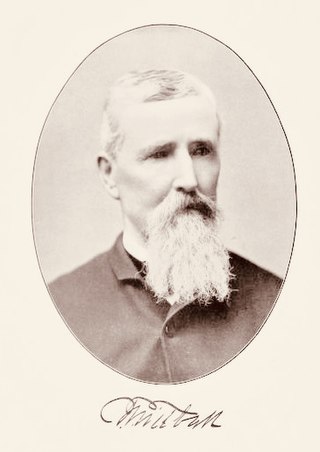
Thomas Theodore Tidball was an American pioneer who came out west during the time of the California gold rush. He was a veteran of the American Civil War who served as a captain in the Union Army. In 1866, Tidball settled in Jolon, California where he and George Dutton purchased the Antonio Ramirez adobe Inn in 1876 and converted it into a two-story hotel and stagecoach station. Tidball went on to establish his own General Store in 1890, which is now the only standing commercial building of Jolon. The Tidball Store is a landmark, which was listed on the National Register of Historic Places on December 12, 1976.
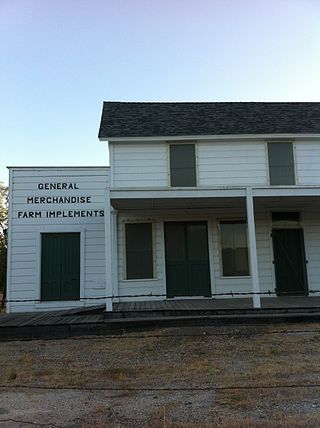
Tidball Store or Jolon General Store is located off Jolon Road in Jolon, California, United States, 1/4 mile south of the Dutton Hotel, Stagecoach Station. The store was constructed by pioneer, Thomas Theodore Tidball, from the remains of an old adobe inn, built in 1868 by Flint & Bixby Stage Lines. Tidball supplied food, clothing, building supplies and other necessities to customers traveling through and to local ranchers and miners. The store was a major stagecoach stop on the old El Camino Real in the late 1880s. The landmark was listed on the National Register of Historic Places on December 12, 1976. It is the only standing commercial building of Jolon, once a major community of southern Monterey County.

The Stevenson House, is a historic two-story Spanish Colonial style building located at 530 Houston Street in Monterey, California. It was a boarding house called the French Hotel, built circa 1836. The Scottish author Robert Louis Stevenson lived there in 1879, writing and courting his future wife. It is now a museum and property of the Monterey State Historic Park. The building was listed on the National Register of Historic Places on January 7, 1972. The building is also listed as a California historical landmark #352.
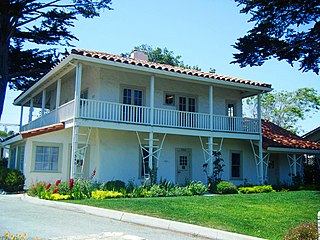
The Vásquez House, also known as Vásquez Adobe, is a historic two-story adobe building located at 546 Dutra Street in Monterey, California. It was occupied by Dolores a sister of Tiburcio Vásquez (1835–1875), who was a Californio bandido that was active in California from 1854 to 1874. The building is listed as a California Historical Landmark #351. It is owned by the City of Monterey, which uses it as the administrative office of its Park and Recreation Department.

The Superior Court of California, County of Monterey, also known as the Monterey County Superior Court or Monterey Superior Court, is the branch of the California superior court with jurisdiction over Monterey County.







